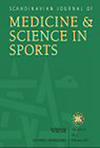操纵跑脚击角对胫骨内负荷的影响。
IF 3.8
2区 医学
Q1 SPORT SCIENCES
引用次数: 0
摘要
对于跑步者来说,胫骨应力性损伤是个问题。脚着地时的击打方式可能会改变胫骨内部负荷,这可能会潜在地影响跑步过程中应力损伤的风险。本研究的目的是量化在跑步时施加后脚和前脚撞击时胫骨远端1/3处的内部负荷。研究人员招募了19名习惯性后脚着地者,让他们先用自己喜欢的后脚着地,然后按随机分配的顺序用后脚和前脚着地跑步。同时采集力和动作捕捉数据,并从运动学数据中识别足部在矢状面上的击打。利用肌肉骨骼模型和梁理论估计胫骨弯矩,并推导出每公里累积加权胫骨冲量。不同的足部敲击方式在峰值弯矩上存在显著差异(p < 0.001)。跑步时施加前脚打击会增加胫骨负荷,尤其是在站立早期到中期(站立2%-67%,p < 0.001)。然而,强制后脚着地导致的弯矩比习惯性后脚着地(p < 0.001)和前脚掌着地(p < 0.001)都要低。此外,与习惯着地(p = 0.001)和后脚着地(p < 0.001)相比,施加前脚着地时每公里累积加权冲量明显更大。由于增加了对足底屈肌的机械需求,用强加的不习惯的前脚打击导致比后脚打击更高的胫骨负荷。对于想要减少胫骨负荷的跑步者来说,从习惯性的后脚着地过渡到前脚着地可能是不明智的。本文章由计算机程序翻译,如有差异,请以英文原文为准。
Influence of Manipulating Running Foot Strike Angle on Internal Loading of the Tibia.
Tibial stress injuries are problematic among runners. Foot strike pattern upon landing may alter internal tibial loading, which could potentially affect the risk of stress injuries during running. The purpose of this study was to quantify internal loading at the distal 1/3 of the tibia during running with imposed rearfoot and forefoot strikes. Nineteen habitual rearfoot strikers were recruited to run with their preferred foot strike and then with imposed rearfoot and forefoot strikes in a randomly assigned order. Force and motion capture data were collected synchronously, and the foot strike in the sagittal plane was identified from the kinematic data. The tibial bending moments were estimated using musculoskeletal modeling and beam theory, and cumulative-weighted tibial impulse per kilometer was derived. Significant differences in peak bending moments were found among foot strike patterns (p < 0.001). Running with an imposed forefoot strike increased tibial loading, especially during early to mid-stance (2%-67% stance, p < 0.001). However, imposed rearfoot striking resulted in lower bending moments than both habitual rearfoot striking (p < 0.001) and forefoot striking (p < 0.001). Additionally, cumulative-weighted impulse per kilometer was significantly greater when running with an imposed forefoot strike compared to both habitual (p = 0.001) and imposed rearfoot strikes (p < 0.001). Running with an imposed nonhabitual forefoot strike results in higher tibial loading than rearfoot striking due to increased mechanical demands placed on the plantar flexors. Transitioning from a habitual rearfoot strike to a forefoot strike may not be advisable for runners aiming to reduce tibial loading.
求助全文
通过发布文献求助,成功后即可免费获取论文全文。
去求助
来源期刊
CiteScore
7.90
自引率
4.90%
发文量
162
审稿时长
3 months
期刊介绍:
The Scandinavian Journal of Medicine & Science in Sports is a multidisciplinary journal published 12 times per year under the auspices of the Scandinavian Foundation of Medicine and Science in Sports.
It aims to publish high quality and impactful articles in the fields of orthopaedics, rehabilitation and sports medicine, exercise physiology and biochemistry, biomechanics and motor control, health and disease relating to sport, exercise and physical activity, as well as on the social and behavioural aspects of sport and exercise.

 求助内容:
求助内容: 应助结果提醒方式:
应助结果提醒方式:


